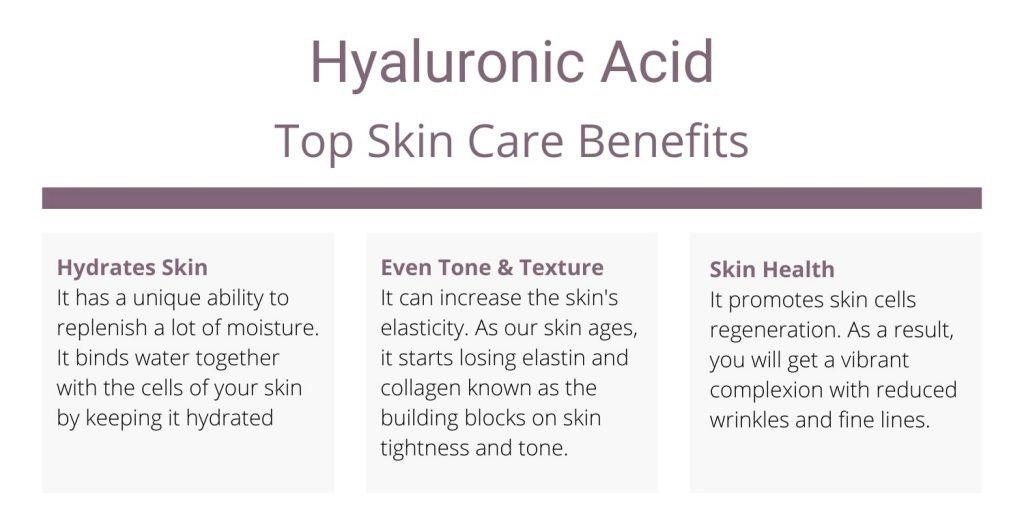Hyaluronic acid, also known as hyaluronan, is a gooey and clear substance that is found in our bodies. The largest amount of it is in our joints, eyes, and skin. The primary function of this substance is to keep our tissues moist and lubricated.
This post may contain affiliate links. Read the full disclosure here
There are two sources of hyaluronic acid – animal origins and plant origins:
- Animal-based hyaluronic acid. It is produced from the combs of roosters (also known as coxcomb) – the red flesh located at the top of the rooster’s head. This type of hyaluronic acid is very close to the one that is found naturally in the human body.
- Not-animal based hyaluronic acid. It is produced through microbial fermentation. A bacterial strain, naturally containing hyaluronic acid, is fermented to yield the perfect molecular weight that is ideal for skincare purposes. Some fermentation processes use soy, others use wheat, so it is important to double-check if you are sensitive to wheat products.
Microbial fermentation remains the most common way to get hyaluronic acid because it is more cost-effective for manufacturers and consumers, and is more eco-friendly because of the reduced production of environmental pollution. Skincare brands usually use plant-based hyaluronic acid, while animal-based hyaluronic acid is usually used in injections and supplements.
Learn how hyaluronic acid compares to niacinamide here.

Benefits of hyaluronic acid for skin
If you wonder what does hyaluronic acid do for your skin, here is the list of its benefits:
Hydrates skin
It has a unique ability to replenish a lot of moisture. By getting into the skin, hyaluronic acid binds water together with the cells of your skin by keeping it hydrated. One gram of hyaluronic acid is able to hold up to six liters of water. As a result, using hyaluronic acid helps your skin look more youthful. Hydrated skin also has fewer wrinkles. It becomes firmer and smoother for a refreshed appearance. In order to increase skin hydration, it is recommended to use a serum.
Increases the process of wound healing
Hyaluronic acid is also known for its antibacterial properties. If you apply it to wounds, you reduce the risk of infection. When you have a skin injury, natural hyaluronic acid contained in your body will also increase in concentration to help repair the injured skin.
Increases skin resilience
Hyaluronic acid improves the ability of the skin to defend against different negative environmental factors and pollutants that age the skin. Since hyaluronic acid occurs naturally in the body, it is not harsh, which means that even people with very sensitive and acne-prone skin can use it without worrying about irritation.
Improves skin tone
Hyaluronic acid is also able to increase the skin’s elasticity. As our skin ages, it starts losing elastin and collagen known as the building blocks for skin tightness and tone. Hyaluronic acid cannot replace elastin but it boosts the skin’s natural ability to retain moisture, which helps it look tighter and better with its natural plump and glow.
Helps skin looks healthier
Hyaluronic acid promotes skin cells regeneration through its added hydration and barrier protection. As a result, you will get a vibrant complexion with reduced wrinkles and fine lines. It also minimizes age spots and prevents the appearance of dark spots in the future.
Protects the skin
Hyaluronic acid helps protect the skin from various harmful forces and toxins, including the sun’s rays, pollution, and smoke. It is especially important as you age because your lipid production slows down.
Reduces eczema
People with mild to moderate eczema notice the reduction in symptoms by using hyaluronic acid-based foam. It is important though to speak with a medical professional first before trying it.

Is it safe to use every day? What are the side effects?
In general, hyaluronic acid products, supplements, and injects are safe if people follow the instructions on how to use them. However, hyaluronic acid may produce allergic reactions and side effects in some people. Therefore, it is always recommended to use a test patch before you start using a new skin product containing this substance.
People receiving injections with hyaluronic acid may experience some side effects that usually disappear within a week. Their side effects include:
- Redness
- Itching
- Pain
- Bruising
- Swelling
However, in most cases, these side effects are a result of the injection process itself rather than hyaluronic acid.
In general, hyaluronic acid rarely causes any side effects because it is naturally produced by our bodies. However, if you have a history of serious allergic reactions, you should be careful when using products containing hyaluronic acid.
One popular product with hyaluronic acid is the Tatcha Dewy Skin Cream. Learn more about this product along with more affordable options here.
Is hyaluronic acid vegan?
In skincare products hyaluronic acid usually is vegan, but it can be animal-derived as well. The plant-based source of hyaluronic acid is completely vegan and cruelty-free. It is produced by the fermentation of a safe bacterial strain. This is the most common option in skincare products given the cost and the impact on the environment.
The non-vegan source of hyaluronic acid is produced from the red flesh on the top of the rooster’s head. Needless to say, this sourcing option is not vegan. This option has mostly been phased out since the discovery of the plant-based option in the 90s. But if you’re concerned about smearing a rooster-flesh product all over your face, it’s best to check with the product manufacturer if the product isn’t explicitly advertised as vegan.
Sodium hyaluronate vs hyaluronic acid – What’s the difference?
Sodium hyaluronate is a salt form of hyaluronic acid that is synthesized in order to create a smaller molecular structure for better resistance to oxidation and stability. Its water solubility and smaller molecular structure mean that it has an ability to penetrate deeper into the skin and provide better hydration. It is a component of anti-aging and moisturizing products due to its ability to hydrate the skin, reduce fine lines, and improve firmness levels. Sodium hyaluronate is often found in such cosmetic products as moisturizers and serums. It also has a form of an oral supplement.
Both hyaluronic acid and sodium hyaluronate offer the same benefits. The primary difference between them is that sodium hyaluronate has a smaller molecular size, which allows it to penetrate the skin better.
What Ingredients can be used with Hyaluronic Acid?
Hyaluronic acid is especially effective in combination with some other ingredients, including retinol, vitamin C, and glycolic acid. To understand why they all work well together, let’s review first what these ingredients are:
- Retinol. It is one of the key anti-aging ingredients. It makes the top layer of skin to turn over faster, which gives skin a healthy and fantastic glow and reduces the appearance of wrinkles and fine lines. Even if you are not concerned about aging yet, retinol still can be beneficial for you. This multi-tasking ingredient is able to address uneven skin tone and control your acne. By delivering increased collagen production at prescription strength, retinol improves the skin’s texture and tone. If you are concerned about the potential side effects of retinol for sensitive skin, consider trying Bakuchiol.
- Vitamin C. Doctors and cosmetologists love vitamin C because it is a great antioxidant and improves collagen production, which means increasing glow and evening out spots. For better results, the concentration of vitamin C in creams and serum should be not less than 20%. However, vitamin C also has its disadvantages. For example, if it is exposed to light and oxygen, it can break down. Therefore, it is important to keep it in airtight packaging and use it at night. In addition, vitamin C is an effective eye cream that helps soften spots and fine lines.
- Glycolic acid. It is one of the most common ingredients in many skincare products. It is derived from sugar cane and belongs to the alpha-hydroxy acid family. This ingredient has many benefits, including acne treatment and anti-aging effects. It also reduces wrinkles and fine lines, minimizes the appearance of pores, removes dead skin cells, and evens the tone of the skin. Another bonus of this ingredient is that it is absolutely safe for new mothers.
Can hyaluronic acid help with acne?
Acne is one of the most common skin disorders that can occur at different phases of our lives. According to scientific research, almost 80% of people experience some sort of acne between the ages of 11 and adulthood. It is usually caused by bacteria, lasting for years, and leave acne scarring. Today, there are many methods to reduce or even eliminate acne scars, and one of the most effective is the use of hyaluronic acid serum.
In order to get rid of the acne scars, you can get treatments with lasers, which are quite effective and give good results. However, it is also possible to use a hyaluronic acid serum that is able to identify water and bind it to skin cells by reducing the collapsed look of acne scars and encouraging healthy tissues over the long term.
However, it is also important to know that hyaluronic acid serums are not good for everyone because they may also contain comedogenic ingredients causing pore-clogging. These ingredients are lanolin (extracted from sheep’s wool) and silicone that traps debris in the skin pores by creating a thin and silky film over the outermost skin layer.
Also Known As:
When scouring the long list of hard-to-pronounce ingredients on the product label, it can be hard to pinpoint certain ingredients. Many of the ingredients we cover go by different names! You may also find hyaluronic acid labeled as followed:
- Sodium Hyaluronate – this is a water-soluble salt form of hyaluronic acid that is thought to be more effective penetrating the skin.
- Hyaluronan – same as hyaluronic acid, this name is often used in scientific nomenclature.
- Glycoaminoglycan – Technically hyaluronic acid is a type of glycoaminoglycan.





